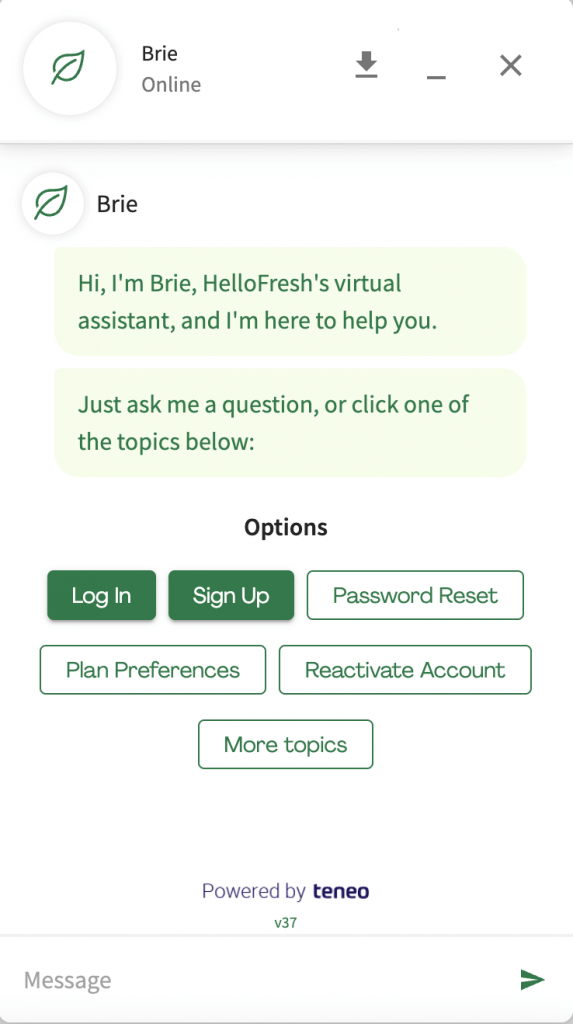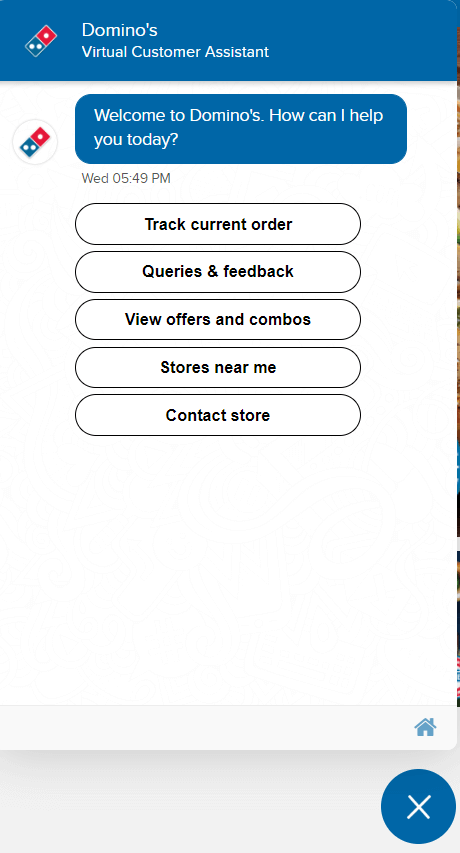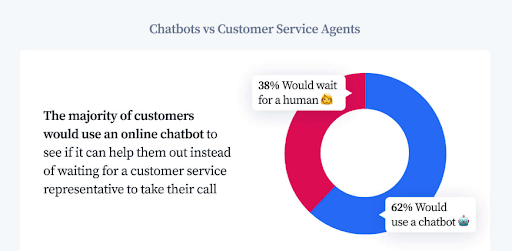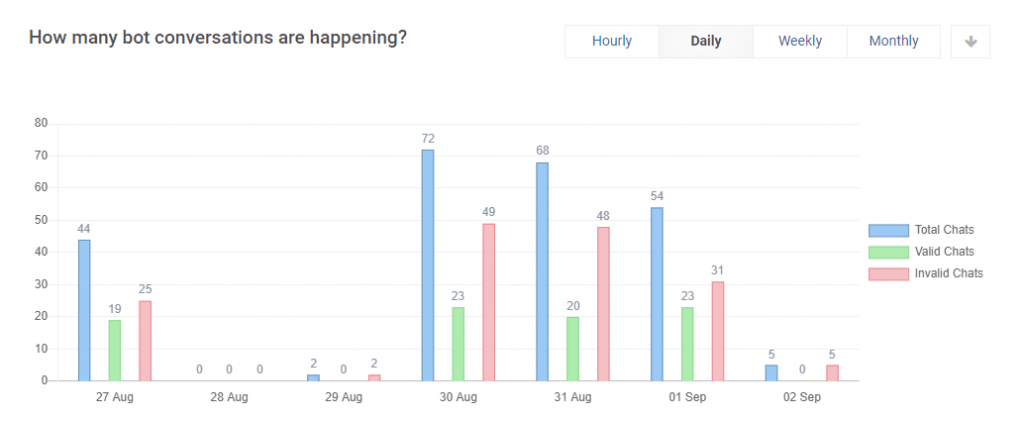Every business today is aware of the supreme power that chatbots possess.
From automating support processes and reducing support costs to capturing leads and improving customer experience, chatbots have proven their worth across diverse business functions.
However, it’s not all sunshine and roses!
There are numerous pitfalls, challenges, and chatbot mistakes that can make these virtual assistants go from awesome to awful in a blink.
This blog sheds light on 12 common chatbot mistakes, such as not providing an easy exit option and not running adequate tests before launching that can cost you your hard-earned customers.
12 Chatbot Mistakes You Must Avoid
The advent of chatbots has transformed the way businesses serve their customers. AI chatbots have taken the customer experience landscape by storm to the extent that —
The global chatbot market size is projected to reach a surprising $3.99 Billion by 2030!
But the fact is, however prevalent and beneficial chatbots are, they can be equally harmful if not implemented the right way. As a technologically-advanced business, you must be abreast with the nuances of using chatbots and the mistakes that you must avoid at any cost.
Let’s learn about the common chatbot mistakes that can cost you billions of dollars if not avoided.
1. Lack of a Clear Purpose, Plan, & Strategy
Just because everyone out there is employing a chatbot doesn’t mean you also have to. If you do so, you are simply following the mob and not solving real business problems.
Before you bring home a chatbot, have a clear What, Why, and How, in your mind.
A chatbot can have multiple use cases – lead generation, customer support, sales, etc. Which of these goals do you have your eyes on?
Are your support agents struggling with growing ticket volume and need a chatbot for assistance?
Does your sales team need a chatbot to get qualified leads and increase conversions?
Do you wish to assist website visitors with the buying process?
Without a strong business case, a clear goal, and a powerful chatbot strategy, your teams will be directionless about how they can best use your chatbot.
Chatbots are cool and nice to have, but investing in them would be futile if they don’t have a purpose to fulfill and a mission to accomplish.
Pro Tip: Talk to your marketing, sales, and support teams and find out the gaps existing in your processes. Identify the business areas that can be improved and problems that can be solved with the help of a chatbot. Once you have a purpose in mind, start creating a strategy, keeping the end results in mind.
You can also opt for a SaaS product like ProProfs Chat that offers all the features you need to build your very own customized bot in minutes.
2. A Chatbot With a Dull Personality
There is a reason people remember Alexa and Siri by their names. These AI-powered voice assistants are smart, interactive, and most importantly, they know how to build a bond with their audience.
However, this is just the cream at the top.
Chatbots need the same level of personalization to leave a lasting impact on customers.
The moment customers see a dull and drab chatbot, they quickly hit the X button and move on. Believe it or not, a lack of personality is a big turn-off for customers. It is one of the most common chatbot mistakes that can cost you dearly in the form of high bounce rates and increased customer frustration.
Does your chatbot have an easy-to-remember name?
Does it have an icon, and does it reflect your company’s branding?
Can it be empathetic and witty at strategic moments?
These simple elements can bring a huge difference in the impression a chatbot leaves on your customers. An appealing personality can be uplifting for frustrated customers and they instantly start feeling positive about the experience.
Here is an excellent example of a chatbot by HelloFresh that goes by the name Brie.
Pro Tip: Humanize your chatbot by giving it a unique name that is easy to spell and remember. Leverage Natural Language Processing (NLP) technology to design conversations that look realistic and not robotic. Remember that your chatbot should be both fun and functional.
3. Not Providing an Easy Exit Option
In haste to keep customers engaged, some businesses end up making funny chatbot mistakes.
For example, fearing the early dropout of customers, most businesses do not provide an easy exit option in chatbots. Calling this a mistake would be an understatement. It’s a big blunder that can induce frustration in customers, leaving a negative brand impression.
You cannot force customers to stay interested in the conversation. All you can do is try. And if customers are stuck in a conversation and feel the need to exit, they should be able to do so with ease.
There are two ways you can make the exit process smooth for customers:
- Make the X button clearly visible at the top of the chatbot
- Provide customers with easy-to-execute next steps such as the option to raise a ticket or a link to your company’s help center.
- Provide an exit option right in the chatbot’s menu
Can you spot the Exit option in the example above?
Pro Tip: There is no point making customers’ stuck in an endless conversation loop. Providing an easy and clear exit door helps maintain trust as customers know that they can gracefully leave the conversation anytime they want.
Read More: 15 Best Chatbot Examples to Skyrocket Your Business
4. Lack of Adequate Testing Before Launch
Rigorous testing is vital for the successful launch of your chatbot.
Lack of it can spoil the entire user experience, putting your brand’s reputation at stake. Without running a series of tests, your chatbot is prone to failing in challenging scenarios that require high levels of intelligence.
Moreover, tests give you the time to prepare your chatbot for the worst scenarios and identify and fix potential errors before going live. You should also test your chatbot for good scenarios, just to be doubly sure that it performs the way it should.
Proper testing is like a preview of how your chatbot will operate when left on its own in the real world. Based on the test results, you can make necessary changes and fine-tune the chatbot so that it gives a stunning show come rain or shine.
Pro Tip: Have a dedicated team work on your chatbot and test it in different scenarios. You can pilot launch the bot in a small setting to gather useful insights about its performance and identify areas for improvement.
5. Choosing the Wrong Chatbot Type
Getting the wrong type of chatbot is another chatbot error that most businesses make.
For example, if you deploy an advanced chatbot for simple things like helping customers place an order and guiding them through the payment process, you are simply wasting your money. A simple, rule-based chatbot would suffice in such situations.
While there are different types of chatbots with varying capabilities on the block, it’s not practical to deploy all of them. To identify what’s right for you, do some introspection to find what it is that your business needs.
What objectives are you looking to achieve with your chatbot?
What kind of functionalities are you expecting from your chatbot?
Do you want a simple chatbot for basic activities or an advanced chatbot for complex functions?
Try to dig deeper to understand the intricacies of different chatbots and choose the one that best fits your business needs and expectations.
Pro Tip: Going hybrid with chatbots can work wonderfully for all business types. Hybrid chatbots provide a middle ground where you get the best of both worlds – simple, rule-based functionality as well as contextual, human-like virtual assistance.
6. Portraying a Chatbot as a Real Human
There is a preconceived notion that customers do not prefer interacting with chatbots.
Well, if we go by the below-given research, this notion is certainly not true.
The problem arises when customers are under the impression that they are talking to a human. Since most NLP-based chatbots sound like humans, it’s difficult to identify whether it’s a chatbot or a real agent on the other side of the screen.
Customers expect the best responses and solutions when they feel they are interacting with a human agent. And in reality, it’s a bot they are talking to. Such situations create chaos, and eventually, customers lose trust in your brand.
That’s why it’s crucial to disclose the bot’s details in the welcome message so that customers can set their expectations right. This helps you build trust and avoid confusion.
Pro Tip: Customers tend to cut some slack for chatbots, but when it comes to human agents, they have high expectations from the start. Let customers know right in the welcome message that they are interacting with a bot so as to avoid any misunderstandings later.
7. Failing to Escalate Issues to Support Agents
No matter how well you train your chatbots, the truth is they can never replace the human brain. While chatbots are great at solving simple issues or problems that require a pre-defined, step-by-step approach, it’s only the human mind that can decode and solve complex queries.
A chatbot can definitely reduce human intervention, but it cannot eliminate it completely.
There comes a point when certain customer issues fall outside the workflow design of a chatbot. That’s when the chatbot should quickly escalate the issue and pass the conversation to an agent so that customers are not kept hanging.
Failure to transfer chats to the right agent at the right time hinders the conversation, forcing customers to use some other channel to seek help. This can be insanely frustrating and disappointing for customers.
Pro Tip: For some critical issues, customers like to have real-time interaction with human agents. Train your chatbot to identify the strategic moments that require human intervention.
For example, when the issue is too complex or when the customer doesn’t seem happy with the response. It is at these moments that the chatbot should quickly route the conversation to the relevant department without keeping the customer waiting.
8. Giving Too Much or Too Little Information
Out of all the chatbot mistakes that businesses make, this is the most prevalent one — a chatbot that gets the content and length of a message wrong.
Many times we see bots bombarding customers with long messages at the start of the conversation. Sure, there might be a lot to tell upfront, but welcoming the customer with lengthy messages is not suitable chatbot etiquette.
It is difficult to digest too much information at once, especially when all customers need is someone who can listen to them patiently.
On the contrary, some bots provide too little information even when customers ask for more. This is another drawback that jeopardizes the overall customer service experience.
So, how can you avoid these chatbot mistakes?
Here are a few tips that can be of help.
Pro tips:
- Be thoughtful of the length of the messages a chatbot sends to customers.
- Narrow down the conversation slowly and drive it towards the solution while ensuring that the customer’s interest doesn’t wane.
- Break long messages into smaller chunks so that they are easy to consume.
A chatbot is synonymous with shorter and crisper conversations that are solution-focused. That’s one major reason customers opt for a chatbot instead of traditional channels like emails and calls. Reading a long message at the start of a conversation is the last thing they would expect from a virtual assistant.
Read More: Top 15 Benefits of Chatbots for Your Business & Customers in 2022
9. Ignoring Chatbot Analytics
Most businesses call it a day after launching a chatbot on their website. That’s a horrible chatbot mistake that can push all your hard work down the drain.
If you think you are done and dusted with the task right after your chatbot is live, use your gray cells and give it a second thought.
Can your chatbot perform optimally on its own?
How do you measure the level of customer engagement happening through your chatbot?
How do you check the total number of interactions carried out by your chatbot?
Like any other tool, chatbots need continuous improvements and updates. For chatbots to blossom to their full potential, you have to keep a close eye on their performance right from the day of launch and make the necessary adjustments.
That’s where chatbot analytics steps in.
The best chatbot tools offer in-depth analytics that helps you track key performance indicators such as customer engagement, chats handled, and validity of conversations. If you brush these analytics under the carpet and expect chatbots to do well on their own, you can’t anticipate the level of damage they can do to your business.
Pro Tip: It’s vital for your chatbot to learn and grow in the process to serve customers better. Track the right KPIs, capture customer feedback, and regularly train your chatbot to be its best version in every single interaction.
10. Sounding Too Scripted, Robotic, and Pushy
Trying too hard to grab customer attention or sell a product can be counterproductive. When customers feel that a chatbot is being too pushy, they tend to leave the conversation right away and go for a more straightforward route like email or phone.
Besides, if a chatbot sounds too robotic or scripted, it results in dull conversations, which can be annoying for customers. There is a big difference between these two chatbot phrases – “Welcome! How can I help you?” and “Hey there. Hope you are doing well! How can I help you today?”
While there is nothing wrong with being straightforward, it’s always better to add an element of warmth to chatbot messages so that customers feel a positive welcome.
AI-powered chatbots work well here. They use technologies like Natural Language Processing and sentiment analysis to send contextual messages that strike the right chords with your customers.
Pro Tips: Your chatbot should be welcoming and straightforward at the same time. It shouldn’t be too pushy trying to promote a new product or service. Instead, it should stick to the issue at hand and try to conduct conversations with the same warmth and energy that a human agent would.
Read More: 10 Chatbot Best Practices for a Business
11. Providing Incorrect or Vague Information
Have you ever come across a salesperson who shows a blank face the moment you ask him the specific details of a product?
At some point, we all have witnessed such situations where we were not fully convinced of the product and had to leave empty-handed.
The same goes for chatbots.
Even if you have an interactive chatbot, it makes no sense if the chatbot provides vague or inaccurate information. Sometimes, bots are not able to comprehend the customer queries if they do not match exactly with the ones recorded in the chatbot. In that case, all the chatbot can say is: “Sorry for the inconvenience. Please try again.”
Offering information that is not helpful or failing to provide any assistance at all ends up ruining the entire experience, resulting in lost sales and dissatisfied customers.
Moreover, it breaks customers’ trust in your brand, and they start questioning the credibility of everything your chatbots say.
Pro Tip: Deploy an AI-powered chatbot that utilizes NLP to offer contextual assistance to customers. Feed all important information in your chatbot so that when the time comes, it is able to answer every customer question with confidence.
The best place to source information is your help center. It will have detailed articles on a variety of topics that chatbots can utilize for solving customer problems.
12. Making the Support Process Hard for Customers
Chatbots have brought a rage in the business world because of two main reasons – incredibly fast speed and 24×7 support.
Adding to the popularity is the fact that chatbots are now replacing tedious human tasks by 4 times — yet another reason every business wants to deploy a chatbot today!
However, most businesses feel that a chatbot can completely replace the customer support system, which is a very naive way of looking at things. You can never fully rely on a chatbot because, at the end of the day, it’s just a trained machine.
Being too confident in your chatbot and not providing customers with the option to talk to a human agent over call can make the issue resolution process harder for customers. Let’s be honest — some critical issues are best handled by human agents over calls, which is why it is essential for your chatbot to make this option instantly available.
Your strategy should be focused on bringing both human and machine intelligence together to craft memorable experiences for customers.
Pro Tip: Do not treat your chatbot as a replacement for your human support team. Deploy the chatbot with the intention of improving the speed of your support process and making things easier for both agents and customers.
Use Your Chatbot Smartly to Win Customers & Save Money
It’s easy to blame the bots every time a customer interaction goes wrong.
Instead of playing the blame game, what you should ideally be doing is identifying the common chatbot mistakes and taking steps to prevent them in the future.
After all, a chatbot is a machine. It is meant to dance to your tunes. For this machine to work systematically, you should learn to avoid chatbot mistakes. You never know when these mistakes will turn into big blunders, ultimately costing you your customers and money.
So before the situation goes out of your hands and everything seems to be falling apart, find out ways to put your chatbot to best use. Create a plan for your chatbot, give it a name and train it to offer accurate information to customers.
A chatbot can be a fantastic tool to grow your business. All you have to do is learn how to use it the right way!
 Tips
Tips
We’d love to hear your tips & suggestions on this article!
FREE. All Features. FOREVER!
Try our Forever FREE account with all premium features!







 We'd love your feedback!
We'd love your feedback! Thanks for your feedback!
Thanks for your feedback!







